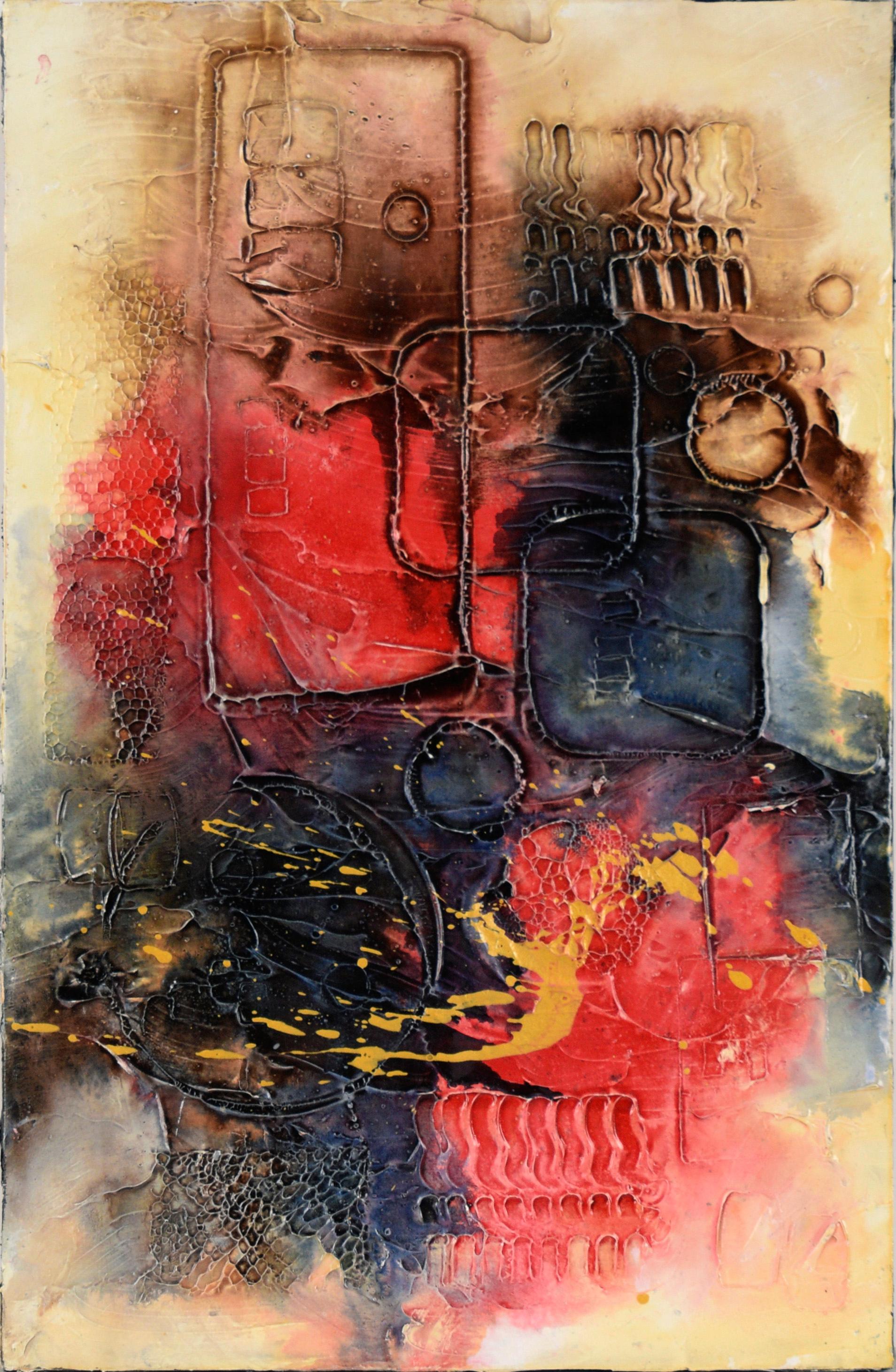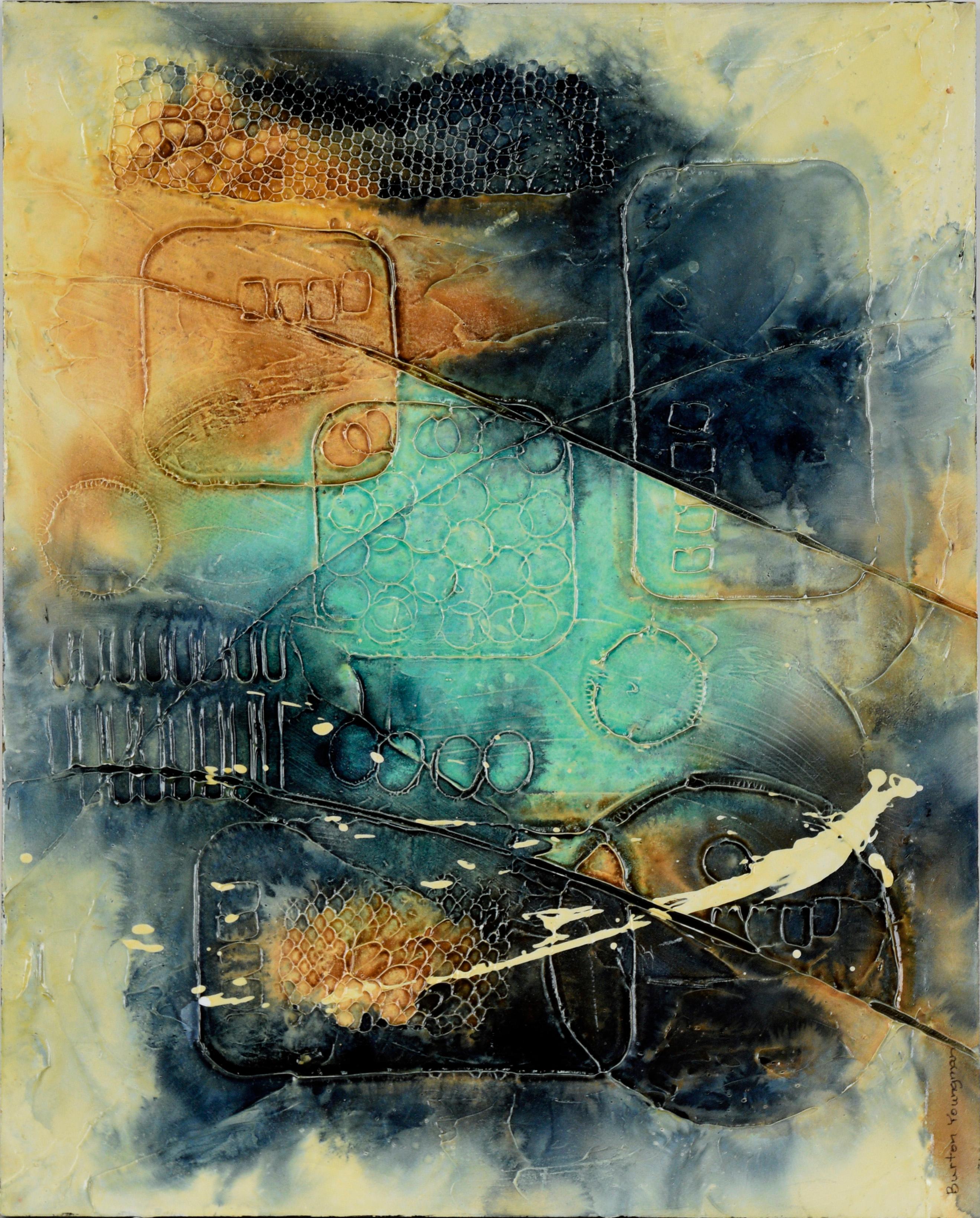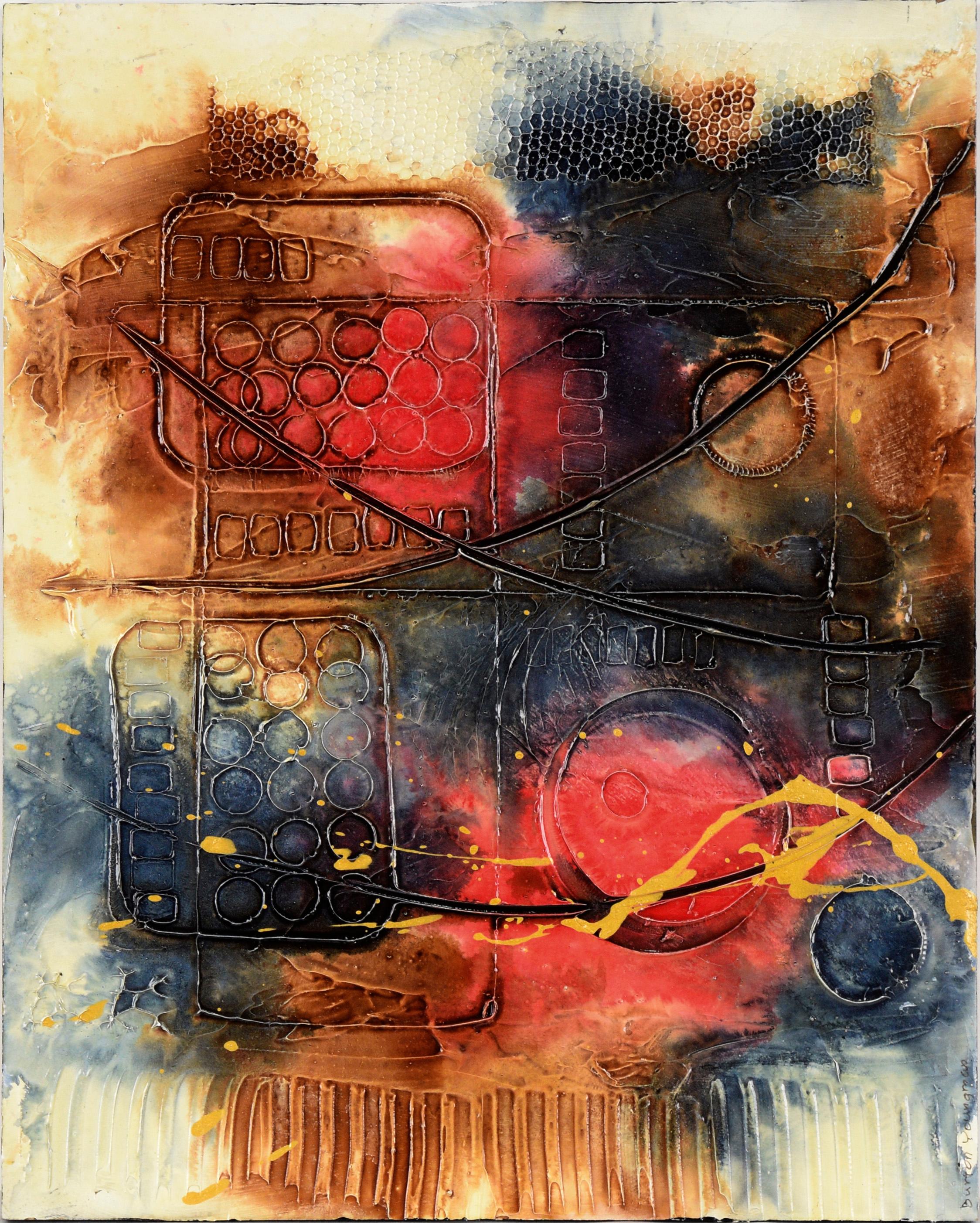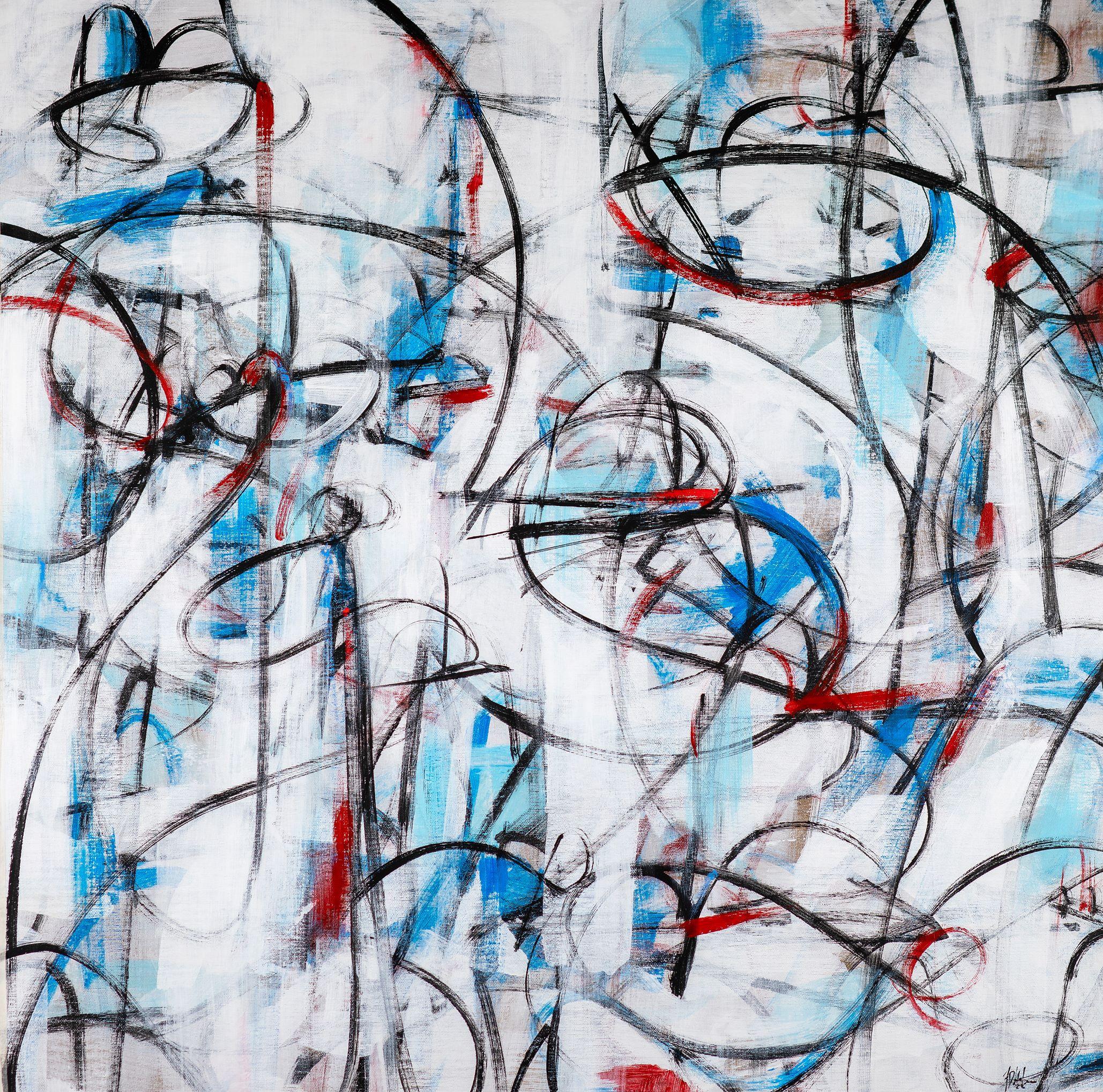Joseph GlascoColorful abstract acrylic collage 20th century painting, New York artist 1978-81
1978-81
About the Item
- Creator:Joseph Glasco (1925 - 1996, American)
- Creation Year:1978-81
- Dimensions:Height: 48 in (121.92 cm)Width: 51 in (129.54 cm)
- Medium:
- Movement & Style:
- Period:
- Condition:
- Gallery Location:Beachwood, OH
- Reference Number:1stDibs: LU176829747782
Joseph Glasco
Joseph Glasco was an American abstract expressionist painter and sculptor. Perhaps one of the best kept secrets and one of the most amazing stories of 20th century art. Glasco was born in Oklahoma in 1925. He rose to fame at the young age of 25 and was given a one man show at one of New York’s leading galleries. He was also the youngest artist to be represented in the permanent collection of the Museum of Modern Art. He was also the 15th artist selected by MOMA to tour in the prestigious “Fifteen Americans” sponsored by MOMA in 1952, along with Pollock, Rothko and others. New York was not his comfort zone. He rebelled against the curators, critics and galleries. He left New York for Taos and ultimately settled in Galveston,TX. Close friends, collectors and sponsors included Stanley Seeger and Julian Schnabel. In 1980, Glasco toured India, Turkey and other countries in the region collecting silks, cloths which he incorporated into a few of his paintings as pictured here. A truly remarkable artist and story as chronicled by Michael Raeburn in The Fifteenth American. He graduated from the University of Texas at Austin. Shortly after, he enlisted in the United States Army during World War II and he served in the Battle of the Bulge. After the war, he enrolled at the Portsmouth Art School in Bristol, England. He also studied at the School of Painting and Sculpture, in San Miguel de Allende, Mexico. He subsequently attended the Art Students League of New York. His works are on permanent display in numerous museums, including The Metropolitan Museum of Art, The Museum of Modern Art, the Solomon R. Guggenheim Museum, the Whitney Museum of American Art in New York City, the Hirshhorn Museum in Washington and The Museum of Fine Arts, Houston.
- ShippingRetrieving quote...Ships From: Beachwood, OH
- Return PolicyA return for this item may be initiated within 14 days of delivery.
- Panama Garden, Mid-century abstract expressionist modern workBy Richard AndresLocated in Beachwood, OHRichard Andres (American, 1927-2013) Panama Garden, c. 1964 acrylic on canvas signed lower right, signed and titled verso 46 x 38 inches Richard Andres was born in Buffalo, New York in 1927. A graduate of the Cleveland Institute of Art in 1950, he was immediately drafted and served for two years in the army as a mural painter. He received his Master of Arts from Kent State in 1961. A frequent exhibitor at galleries and museums and winner of multiple May Show prizes, Andres taught art in the Cleveland Public Schools for 28 years, as well as teaching the University of Buffalo, the Cleveland Institute of Art and the Western Reserve University. Very little in Richard Andres’ childhood would have predicted his love of classical music, mid-century-modern architecture and certainly not his lifelong passion for art and in particular abstract art. Richard’s father, Raymond, had no more than a third-grade education, and his mother, Clara, was one of thirteen children – only three of whom lived into adulthood and none of whom attended high school. They lived, when Richard was a boy, in a dingy area of Buffalo, NY in a walk-up apartment situated above a tavern. Raymond and Clara supplemented the income from their factory jobs in the bar downstairs with Raymond playing ragtime on the piano and Clara serving drinks. This often left Richard and his two older brothers at home alone to fend for themselves. The two older boys, Raymond and Russell, were - unlike Richard- rather rough and tumble and entertained themselves with stickball, boxing and the like. Richard, on the other hand, from a very young age liked to draw, or better yet even, to paint with the small set of watercolors he received for Christmas one year. Paper, however, at the height of the depression, was hard to come by. Luckily, Clara used paper doilies as decoration for the apartment and Richard would contentedly paint and then cut up doilies, gluing the pieces together to create collages. At eight-years-old, he discovered the Albright-Knox Museum (then known as the Albright Art Gallery) and spent several hours a week there studying the paintings. He was particularly fond of Charles Burchfield‘s landscapes, enamored with their ‘messiness’ and thinking that they somehow captured more ‘feeling’ than works he was previously familiar with. For his tenth Christmas, he asked for and received a ‘how-to’ paint book by Elliot O’Hare. Through this self-teaching, he assembled the portfolio needed for acceptance to Buffalo Technical High School where he studied Advertising Arts. In his Junior year, he was encouraged to enter a watercolor painting, “Two Barns,” in the national 1944-45 Ingersoll Art Award Contest and was one of twelve grand prize winners – each one winning one hundred dollars. More importantly the painting was exhibited at the Carnegie Institute Galleries, which resulted in his winning a national scholarship to the Cleveland School of Art (The Cleveland Art Institute). He flourished at the art school under the tutelage of faculty members such as Carl Gaertner, as well as that of visiting artists such as William Sommer and Henry George Keller. He would say in later years that Gaertner, in particular, influenced his attitude toward life as well as art. “Gaertner,” Andres said, “believed that there was no need to be a ‘tortured artist’, that an artist should rather enjoy beauty, family, and life in general.” Free to spend his days as he chose, he wandered the Cleveland Art Museum for most of the hours he was not attending classes or painting; the remaining time was spent drinking coffee at a local hangout with art school friends – which is where he met fellow Henry Keller scholarship winner, Avis Johnson. Richard was immediately smitten with Avis, but being rather shy, it took him the entire summer of 1948 to build up his courage to ask her out. Over that summer he ‘thought about Avis’ and worked in a diner to save money. He also used the hundred-dollar prize money won in High School to visit the first Max Beckmann retrospective in the United States at the City Art Museum in St. Louis. Over a half century later he spoke of that exhibit with a reverence usually reserved for spiritual matters, “I walked in and it was like nothing I had ever seen before... the color...It just glowed.” Returning to campus in the Fall, the first thing he did was go to the coffee shop in hopes of finding Avis. He did, and she, upon seeing him, realized that she was also smitten with him. They quickly became known as ‘the couple’ on campus, and a year later, with Richard being drafted for the Korean war, they were quickly married by a Justice of the Peace, celebrating after with family at Avis’s Cleveland home. As a gift, faculty member John Paul Miller...Category
1960s Abstract Expressionist Abstract Paintings
MaterialsAcrylic
- Garden, Abstract Expressionist Mid-Century Modern geometric workBy Richard AndresLocated in Beachwood, OHRichard Andres (American, 1927-2013) Garden, 1972 acrylic on canvas signed, dated and titled verso 59.5 x 50 inches Richard Andres was born in Buffalo, New York in 1927. A graduate of the Cleveland Institute of Art in 1950, he was immediately drafted and served for two years in the army as a mural painter. He received his Master of Arts from Kent State in 1961. A frequent exhibitor at galleries and museums and winner of multiple May Show prizes, Andres taught art in the Cleveland Public Schools for 28 years, as well as teaching the University of Buffalo, the Cleveland Institute of Art and the Western Reserve University. Very little in Richard Andres’ childhood would have predicted his love of classical music, mid-century-modern architecture and certainly not his lifelong passion for art and in particular abstract art. Richard’s father, Raymond, had no more than a third-grade education, and his mother, Clara, was one of thirteen children – only three of whom lived into adulthood and none of whom attended high school. They lived, when Richard was a boy, in a dingy area of Buffalo, NY in a walk-up apartment situated above a tavern. Raymond and Clara supplemented the income from their factory jobs in the bar downstairs with Raymond playing ragtime on the piano and Clara serving drinks. This often left Richard and his two older brothers at home alone to fend for themselves. The two older boys, Raymond and Russell, were - unlike Richard- rather rough and tumble and entertained themselves with stickball, boxing and the like. Richard, on the other hand, from a very young age liked to draw, or better yet even, to paint with the small set of watercolors he received for Christmas one year. Paper, however, at the height of the depression, was hard to come by. Luckily, Clara used paper doilies as decoration for the apartment and Richard would contentedly paint and then cut up doilies, gluing the pieces together to create collages. At eight-years-old, he discovered the Albright-Knox Museum (then known as the Albright Art Gallery) and spent several hours a week there studying the paintings. He was particularly fond of Charles Burchfield‘s landscapes, enamored with their ‘messiness’ and thinking that they somehow captured more ‘feeling’ than works he was previously familiar with. For his tenth Christmas, he asked for and received a ‘how-to’ paint book by Elliot O’Hare. Through this self-teaching, he assembled the portfolio needed for acceptance to Buffalo Technical High School where he studied Advertising Arts. In his Junior year, he was encouraged to enter a watercolor painting, “Two Barns,” in the national 1944-45 Ingersoll Art Award Contest and was one of twelve grand prize winners – each one winning one hundred dollars. More importantly the painting was exhibited at the Carnegie Institute Galleries, which resulted in his winning a national scholarship to the Cleveland School of Art (The Cleveland Art Institute). He flourished at the art school under the tutelage of faculty members such as Carl Gaertner, as well as that of visiting artists such as William Sommer and Henry George Keller. He would say in later years that Gaertner, in particular, influenced his attitude toward life as well as art. “Gaertner,” Andres said, “believed that there was no need to be a ‘tortured artist’, that an artist should rather enjoy beauty, family, and life in general.” Free to spend his days as he chose, he wandered the Cleveland Art Museum for most of the hours he was not attending classes or painting; the remaining time was spent drinking coffee at a local hangout with art school friends – which is where he met fellow Henry Keller scholarship winner, Avis Johnson. Richard was immediately smitten with Avis, but being rather shy, it took him the entire summer of 1948 to build up his courage to ask her out. Over that summer he ‘thought about Avis’ and worked in a diner to save money. He also used the hundred-dollar prize money won in High School to visit the first Max Beckmann retrospective in the United States at the City Art Museum in St. Louis. Over a half century later he spoke of that exhibit with a reverence usually reserved for spiritual matters, “I walked in and it was like nothing I had ever seen before... the color...It just glowed.” Returning to campus in the Fall, the first thing he did was go to the coffee shop in hopes of finding Avis. He did, and she, upon seeing him, realized that she was also smitten with him. They quickly became known as ‘the couple’ on campus, and a year later, with Richard being drafted for the Korean war, they were quickly married by a Justice of the Peace, celebrating after with family at Avis’s Cleveland home. As a gift, faculty member John Paul Miller...Category
1970s Abstract Expressionist Abstract Paintings
MaterialsAcrylic
- Erie Shore, Large Abstract Expressionist Mid-Century Modern geometric workBy Richard AndresLocated in Beachwood, OHRichard Andres (American, 1927-2013) Erie Shore, c. 1975 acrylic on canvas signed lower right, signed and titled verso 50 x 72 inches Richard Andres was born in Buffalo, New York in 1927. A graduate of the Cleveland Institute of Art in 1950, he was immediately drafted and served for two years in the army as a mural painter. He received his Master of Arts from Kent State in 1961. A frequent exhibitor at galleries and museums and winner of multiple May Show prizes, Andres taught art in the Cleveland Public Schools for 28 years, as well as teaching the University of Buffalo, the Cleveland Institute of Art and the Western Reserve University. Very little in Richard Andres’ childhood would have predicted his love of classical music, mid-century-modern architecture and certainly not his lifelong passion for art and in particular abstract art. Richard’s father, Raymond, had no more than a third-grade education, and his mother, Clara, was one of thirteen children – only three of whom lived into adulthood and none of whom attended high school. They lived, when Richard was a boy, in a dingy area of Buffalo, NY in a walk-up apartment situated above a tavern. Raymond and Clara supplemented the income from their factory jobs in the bar downstairs with Raymond playing ragtime on the piano and Clara serving drinks. This often left Richard and his two older brothers at home alone to fend for themselves. The two older boys, Raymond and Russell, were - unlike Richard- rather rough and tumble and entertained themselves with stickball, boxing and the like. Richard, on the other hand, from a very young age liked to draw, or better yet even, to paint with the small set of watercolors he received for Christmas one year. Paper, however, at the height of the depression, was hard to come by. Luckily, Clara used paper doilies as decoration for the apartment and Richard would contentedly paint and then cut up doilies, gluing the pieces together to create collages. At eight-years-old, he discovered the Albright-Knox Museum (then known as the Albright Art Gallery) and spent several hours a week there studying the paintings. He was particularly fond of Charles Burchfield‘s landscapes, enamored with their ‘messiness’ and thinking that they somehow captured more ‘feeling’ than works he was previously familiar with. For his tenth Christmas, he asked for and received a ‘how-to’ paint book by Elliot O’Hare. Through this self-teaching, he assembled the portfolio needed for acceptance to Buffalo Technical High School where he studied Advertising Arts. In his Junior year, he was encouraged to enter a watercolor painting, “Two Barns,” in the national 1944-45 Ingersoll Art Award Contest and was one of twelve grand prize winners – each one winning one hundred dollars. More importantly the painting was exhibited at the Carnegie Institute Galleries, which resulted in his winning a national scholarship to the Cleveland School of Art (The Cleveland Art Institute). He flourished at the art school under the tutelage of faculty members such as Carl Gaertner, as well as that of visiting artists such as William Sommer and Henry George Keller. He would say in later years that Gaertner, in particular, influenced his attitude toward life as well as art. “Gaertner,” Andres said, “believed that there was no need to be a ‘tortured artist’, that an artist should rather enjoy beauty, family, and life in general.” Free to spend his days as he chose, he wandered the Cleveland Art Museum for most of the hours he was not attending classes or painting; the remaining time was spent drinking coffee at a local hangout with art school friends – which is where he met fellow Henry Keller scholarship winner, Avis Johnson. Richard was immediately smitten with Avis, but being rather shy, it took him the entire summer of 1948 to build up his courage to ask her out. Over that summer he ‘thought about Avis’ and worked in a diner to save money. He also used the hundred-dollar prize money won in High School to visit the first Max Beckmann retrospective in the United States at the City Art Museum in St. Louis. Over a half century later he spoke of that exhibit with a reverence usually reserved for spiritual matters, “I walked in and it was like nothing I had ever seen before... the color...It just glowed.” Returning to campus in the Fall, the first thing he did was go to the coffee shop in hopes of finding Avis. He did, and she, upon seeing him, realized that she was also smitten with him. They quickly became known as ‘the couple’ on campus, and a year later, with Richard being drafted for the Korean war, they were quickly married by a Justice of the Peace, celebrating after with family at Avis’s Cleveland home. As a gift, faculty member John Paul Miller...Category
1970s Abstract Expressionist Abstract Paintings
MaterialsAcrylic
- Summer Idyl, abstract expressionist painting by Cleveland School artistBy Richard AndresLocated in Beachwood, OHRichard Andres American, 1927-2013 Summer Idyl, c. 1985 acrylic and ink on paper mounted on canvas signed lower right, signed and titled verso 44.75 x 62.75 inches Richard Andres wa...Category
1980s Abstract Expressionist Abstract Paintings
MaterialsInk, Acrylic
- Reflections, large abstract expressionist painting by Cleveland School artistBy Richard AndresLocated in Beachwood, OHRichard Andres American, 1927-2013 Reflections, 1985 acrylic and ink on paper mounted on canvas signed lower right, signed, dated and titled verso 52.5 x 72.5 inches 53 x 73 inches, ...Category
1980s Abstract Expressionist Abstract Paintings
MaterialsInk, Acrylic
- Untitled abstract expressionist oil painting by Cleveland School artistBy Richard AndresLocated in Beachwood, OHRichard Andres American, 1927-2013 Untitled, c. 1984 acrylic and ink on paper mounted on canvas signed lower right 19 x 16 inches Richard Andres was born in Buffalo, New York in 192...Category
1980s Abstract Expressionist Abstract Paintings
MaterialsInk, Acrylic
- "In A Mood" Large Scale Acrylic, Oil Pastels, and Pencils Abstract 72"x96"By Karina GentinettaLocated in New York, NY"In A Mood" 2023, 72" H x 96" W. Large scale abstract painting consisting of acrylic, pencils, and oil pastels on canvas by Argentine-born artist Karina Gentinetta (featured in Elle ...Category
21st Century and Contemporary Abstract Expressionist Abstract Paintings
MaterialsOil Pastel, Acrylic, Carbon Pencil, Color Pencil, Watercolor
- "Adagio in Blue" Large Scale Acrylic, Oil Pastels, Pencils Blue Abstract 72x96By Karina GentinettaLocated in New York, NY"Adagio in Blue" 2023, 72" H x 96" W. Large Scale horizontal abstract painting consisting of acrylic, home paint, pencils and oil pastels on canvas by Argentine-born artist Karina G...Category
21st Century and Contemporary Abstract Expressionist Abstract Paintings
MaterialsOil Pastel, House Paint, Acrylic, Carbon Pencil, Color Pencil
- Textured Abstract Expressionist Composition (I) in Acrylic on BoardLocated in Soquel, CATextured Abstract Expressionist Composition in Acrylic on Board Textured and detailed abstract composition by Loretta Burton Youngman (American, b. 1943). Red and charcoal blue patc...Category
21st Century and Contemporary Abstract Expressionist Abstract Paintings
MaterialsPlaster, Glaze, Acrylic
- Textured Abstract Expressionist Composition (III) in Acrylic on BoardLocated in Soquel, CATextured Abstract Expressionist Composition in Acrylic on Board Textured and detailed abstract composition by Loretta Burton Youngman (American, b. 1943). Teal and charcoal blue pat...Category
21st Century and Contemporary Abstract Expressionist Abstract Paintings
MaterialsPlaster, Glaze, Acrylic
- Textured Abstract Expressionist Composition (II) in Acrylic on BoardLocated in Soquel, CATextured Abstract Expressionist Composition in Acrylic on Board Textured and detailed abstract composition by Loretta Burton Youngman (American, b. 1943). Red and charcoal blue patc...Category
21st Century and Contemporary Abstract Expressionist Abstract Paintings
MaterialsPlaster, Glaze, Acrylic
- "Tetico" contemporary Italian abstract painting musical rhythm dancing energyLocated in Kowloon, Hong KongFrancesco is the painter of music. Deep in the night where the painter is not sleeping, being a musician, instead of writing songs, he starts to capture the musical rhythm dancing i...Category
2010s Abstract Expressionist Abstract Paintings
MaterialsCanvas, Mixed Media, Acrylic, Pigment






